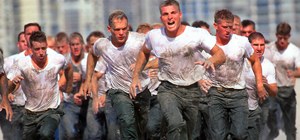Challenge Yourself
 Saturday, October 15, 2011 at 03:37PM
Saturday, October 15, 2011 at 03:37PM  CAtennis
CAtennis There are key points in a tough match where you have to dig deep and find the motivation that you need in order to push through the barriers of pain and the obstacles posed by your opponent. You can find yourself at 5-5 in the third set on a brutal, hot and humid summer day. How do you deal with these situations?! The reality is that as you progress in the game, you will face greater obstacles and more momentous occasions.
To overcome these situations it helps if, in addition to your standard training and workouts, you include some sort of physical challenge into your routine. Be it running up hills (like Andre Agassi or Jerry Rice), sprinting up sand dunes (like Marv Dunphy's Pepperdine volleyball team), running miles through the desert or in the snow, jumping rope for 2 hours straight, biking a century, participating in a survival race or something equally taxing, having an "extra-curricular" training method that is extra tough will assist you on the tennis court. Some of these methods can also improve your overall fitness, so that's a bonus.

More importantly, however, they make the voice inside your head telling you to keep going louder and more convincing ("you CAN do it", "come on PUSH it"). When you're on the court, you're out there by yourself. You can have 1000 fans supporting you or 1000 fans rooting against you (and if you make the NCAAs you will experience both). But only one voice matters and that's the voice that's inside your head; your INNER COACH. It can tell you to give up ("it's OK to quit; losing's fine") or to keep going ("no pain, Rocky! No Pain!"). If you include a difficult training method into your routine - even if it's once every 2-3 weeks - you can recall the positive voice inside you. You say to yourself "hey, if I did THAT I sure as heck can do THIS." Or, "I'll be darned if I'm going to let this son-of-a-gun run away with this match. He didn't run up those hills in the middle of summer...all by himself! I DID! There's no way he's beating me".
